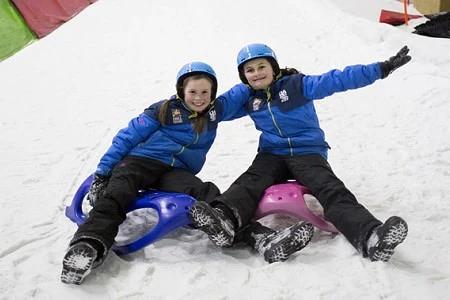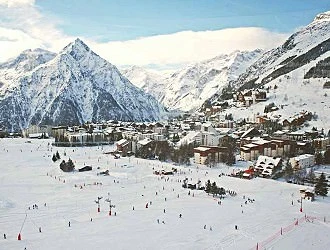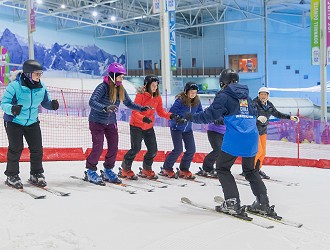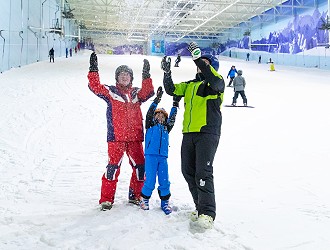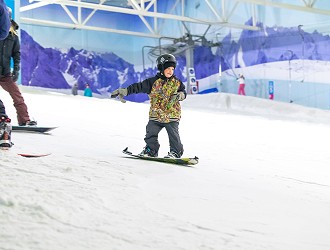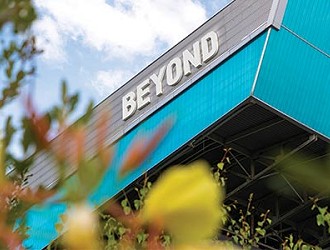Learning to snowboard on a dry slope vs real snow - what is the difference?

Learning to snowboard on a dry slope is a convenient way to get into the world of snowboarding and skiing if you don’t have access to a real snow slope. The accessibility of a dry slope gives newbies a great chance of learning. So, what’s the difference between a dry slope and a real snow slope, and how do they compare as an experience? Continue reading to find out.
What is a dry slope?
A dry ski slope is a man-made ski slope that runs down an outdoor hill and is constructed with materials that allow snowboards (and skis) to slide on top.
The most common modern material for dry ski slopes is Dendix. It features plastic bristles arranged in a hexagonal shape on top of a mat with a hole in the middle of each hexagon to reduce friction. To maintain a smooth ski experience, the mats are always watered with a sprinkler system. This further reduces friction and helps to reduce wear and tear on snowboards and skis.
A dry slope normally runs about 150 metres in length, but there are longer ones. The longest dry ski slope is currently located in Veduchi in Russia, which is approximately 1,130m in length.
Snowboarding on a dry ski slope
Unless you live in a snowy mountainous area of Scotland, then your chances of experiencing a real snow slope outdoors are slim. It means that your best prospect of snowboarding outdoors is to use dry slopes. Of course, there are a number of indoor real snow slopes for you to experience too, but if you’re hellbent on an outdoor experience, you’ll be better off finding a dry slope.
Dry slopes are a year-round way of making your first moves on a snowboard, helping you to hone your skills whenever you’d like. If you’re waiting for the winter season to experience a real snow slope outdoors, you’ll be missing out on precious snowboarding opportunities throughout the other months of the year.
If you’ve never been on a snowboard before, learning to snowboard on a dry slope can help you find your feet before you hit the real snow. Some winter sports are quicker to get to grips with, but snowboarding can often take a little longer than you may think. Of course, this doesn’t apply to everyone, but many people find sledging, skating and skiing much easier than snowboarding. As a result, snowboarding needs the most practice, and dry slopes offer a great way to help you get started.
First steps towards learning to snowboard on a dry slope
Typically, the first hour of snowboarding can be very difficult for a beginner. But, as you get used to the feel of the board under your feet and at which angle you have to ride the slope, it does get easier. Of course, some people learn much quicker than others, while it can take slightly longer for some.
Because it normally takes a couple of days to get used to the hang of the correct snowboarding technique, you can expect to have a few slips and trips. The great thing about falling on a dry slope is that you won’t be cold and wet like you would falling on a real snow slope.
However, one negative aspect of a dry slope is that when you do fall it can be more painful than snow. The plastic mesh that makes a dry slope what it is can be hard to fall on, and can even scratch and tear clothing. So, remember to make sure you’re fully protected and wrapped up to protect you from any falls!
What to wear when learning to snowboard on a dry slope
When it comes to clothing and equipment, not much differs between real snow slopes and dry slopes. You will still want to dress with layers to protect against any falls and in order to keep you warm. If you’re lucky and the weather is warm, you should still wear a long sleeve item of clothing to protect your skin during a tumble.
You should also try to wear waterproof and windproof outfits because they’re a good way of ensuring that a little bit of rain doesn’t bring your snowboarding lesson to a halt.
Other important snowboarding accessories include sunglasses and some gloves. Sunglasses help to prevent sun glare from disrupting your vision as you cruise down a slope, while gloves are just another layer of protection from injury as you’ll put your hands out in front of you during a fall. Gloves, of course, also help to keep your hands warm as you hurtle down the slope.
Snowboarding lessons at Chill Factore
Before you hit the dry slopes, consider an indoor setting with real snow at Chill Factore. If you’ve never been snowboarding before, then you should think about taking some snowboarding lessons.
Lessons for snowboarding at Chill Factore take place on a real snow slope that give you an authentic experience and get you prepared for outdoor terrain. You’ll learn how to snowboard with the guidance of qualified instructors, all of whom receive continuous training and hold the British Association of Snowsport Instructors Level 1 qualification or equivalent as a minimum.
Real indoor snow at Chill Factore
Nothing allows you to experience a snowy mountain in the UK quite like the real indoor snow ski slope at Chill Factore. With cool air and fresh snow every night, it provides guests with both the look and feel of skiing and snowboarding on mountainous terrain.
Chill Factore, near the Trafford Centre, is packed with fun things to do for the whole family. We’re home to the longest real snow slope in the UK. And what says fun more than real snow – and lots of it? From sledging to ski lessons and private tuition, we’ve got something for everyone. There’s even a comfortable viewing gallery for the less intrepid, so you can sit back, enjoy a coffee, and watch the excitement unfold.
All you need to do to get involved is to contact us on 0161 749 2222 or email us at info@chillfactore.com to book a family day out.


